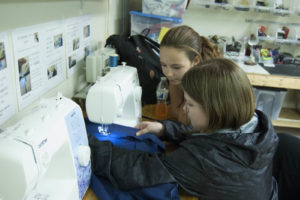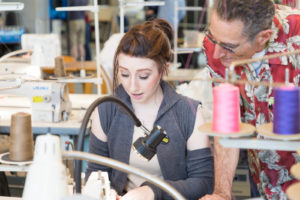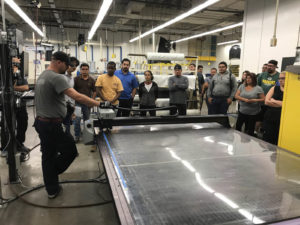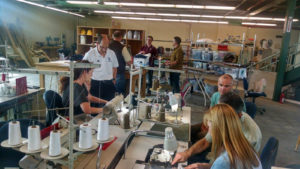
Labor shortages are real and troubling, but a variety of organizations and manufactures are working on strategies to attract the next generation of workers–getting actively involved with public education and student training and recruitment.
The dearth of skilled labor is an increasingly common lament heard from manufacturers of all stripes. It’s not a sudden or inflated complaint. According to recent data provided by the Manufacturing Institute (the Institute, or MI), an affiliate of the National Association of Manufacturers (NAM) based in Washington, D.C., 364,000 manufacturing jobs are going unfilled. The situation seems likely to worsen; a Deloitte LLP/MI Skills Gap study released in February 2015 projects that by 2025 there will be 3.5 million manufacturing jobs generated—with two million of those wanting for workers.
“This challenge is real and current,” says Carolyn Lee, executive director of the Institute. “In the latest NAM Manufacturers Outlook Survey released last December, the inability to attract and retain a quality workforce was the top business challenge, cited by 72.9 percent of the respondents.”
Manufacturers continually cite this as their biggest concern, Lee says. The survey also revealed that nearly 80 percent of those responding said they’re currently struggling to fill positions; a little more than 34 percent said the inability to find qualified workers has affected their ability to take on new business, resulting in lost revenue opportunities. Threatening to exacerbate the situation are the exiting baby boomers, many of whom are already retiring or plan to do so in the near future, making attracting the next generation of workers (millennials, or the oncoming “Generation Z”) essential for survival.
Finders keepers?
Retention isn’t a problem for Andy Moon, CEO of Baraboo Tent & Awning Inc.; most of his 20-plus employees have been around for 10 years, some for more than 40 years. Located in Baraboo, Wis., the company manufactures awnings, boat covers, restaurant umbrellas and other industrial fabric products. Although he’s currently well-staffed, Moon expects to lose four or five long-time employees to retirement over the next several years—he’s already lost one employee this way—and is anticipating a potential labor shortage as a result.
Jonathan Palmer, president of Autometrix Inc., agrees that there are labor concerns. “I’m not sure there’s a shortage of trainable employees, but they’re hard to find because there’s usually competition when you go to hire them. Finding people with the right basic skills and, perhaps most importantly, the right attitude is always the challenge.” Headquartered in Grass Valley, the Nevada County, Calif., company creates pattern management software and builds precision cutting machines for a variety of industries.
The NAM study reveals that employment opportunities in manufacturing are growing and becoming more diverse, says Lee. Along with the more traditional roles like production workers, maintenance techs and welders (“Roles all in demand,” she says), there are what she refers to as “new-collar jobs”: positions calling for those skilled in graphic design, robotics and computer/data research.
The nature of work
Carol Pepper-Kittredge, statewide project director for the California Community Colleges (CCC) Maker program, says it’s important to understand how the work arena is transforming; and consequently, what skills might be needed over the next several years. Pepper-Kittredge is with Sierra College in Rocklin, Calif., which serves as the fiscal agent and project manager for the statewide project, involving 24 CCC Maker colleges throughout California tasked with: nurturing and supporting a maker culture, welcoming nontraditional students, encouraging innovation and entrepreneurship, and creating employment opportunities and viable career pathways for participants.
“Automation and machine learning are changing the nature of work and redefining the types of skilled jobs that are emerging,” she explains. “An example is the use of smart textiles designed to monitor patient health or provide treatment. The workforce of the future must be tech-proficient and human-centered, social and analytical.”
At the February 2018 annual meeting of Girl Scouts Heart of California, Carol Pepper-Kittredge received the council’s 2017 Community Partner of the Year award, recognizing her assistance in planning and building a community of practice for the recently launched Girl Scout STEM Center + MakerSpace located in Sacramento. A second site is under construction in Modesto and is expected to open in late summer 2018.
Attracting more people to manufacturing requires altering how the industry is regarded, says Lee. And it should start at an early age.
“Teachers and parents need to understand why there’s a future in manufacturing and encourage kids to seek a rewarding career in the industry,” Lee says. “Manufacturers cannot solve this problem on their own. We need all parties—manufacturers, educators, community leaders—to come together and work to attract the next generation of workers.”

The next generation
The Manufacturing Institute and NAM hold an annual Manufacturing Day the first Friday of October to showcase the work manufacturers do, and to educate students, the community, media and policymakers on manufacturing’s importance to the local, national and global economies, says Lee. Last year, almost 3,000 events were held across the United States; 84 percent of the students who attended said they are feeling more convinced that manufacturing offers interesting and rewarding careers.
FabNewport, started in 2013 in Newport, R.I., is a Fab Lab (Fabrication Lab) Makerspace that “teaches kids how to make stuff,” says Steve Heath, executive director, through a variety of informal and formal programs, such as coding, 2-D and 3-D design, electronics, sewing and personalized manufacturing. Focused primarily on 10-to-18-year-olds, FabNewport also offers programming for families.
“Children should be learning what they love to do from an early age and continue to grow their skills based on their interests,” says Heath. “My goal is to create hands-on programs for children to discover their talents and find ways to connect to the world with meaning.”
FabNewport works with approximately 200 school-aged children weekly during the school year, also participating in fairs and community events and hosting a summer maker party. FabNewport offers after-school programs for school credits; a summer camp for 10-to-15-year-olds; “drop-in” programming on Fridays and Saturdays for kids starting at age eight; and family programs on Friday evenings.
“Thousands of children have participated in some iteration of our programs. Our program has evolved to the point where we’d like to keep our Newport lab thriving and also put energy into coaching other communities how to launch a ‘Make Your Life Program.’ We’re working on building an ecosystem of learning, and interest is growing across the state,” says Heath, adding that they’re in the process of opening 10 spaces in the 10 Providence public libraries.
The CCC Maker program is also carrying on the effort, ensuring that seeds planted continue to thrive. Student interest is strong. Cumulative quarterly figures (July through December 2017) provided by Pepper-Kittredge show that 9,158 students participated in CCC Maker makerspace activities during that period.
“Makerspaces are perfect environments for extended learning and community building,” says Pepper-Kittredge. “Skills learned on the job accelerate job proficiency and competency, but the ability to learn by experimenting, failing or iterating might be reduced or eliminated because a product or service needs to be produced quickly and efficiently.”

Full STEAM ahead
Chris Semonelli is vice president/sales manager for Erez USA Inc., a company that manufactures high-performance textiles for about 20 markets, among them rigid inflatable boats and whitewater rafts, environmental control and geomembranes, life preservers and tension structures. The U.S. marketing and sales office is located in Newport, R.I.; the main manufacturing facility and headquarters is in Israel.
Semonelli is on the board of FabNewport and has been involved in STEAM (Science, Technology, Engineering, the Arts and Mathematics) for 10 years.
“A group of us noticed no mentor or internship programs existed for local students,” he says. “We started filling up busses with students, sending them to local businesses like composite manufacturers, the Naval War College, local hospitals, manufacturing facilities, the local naval base and so on, to expose them to career pathways.”
His group is comprised of approximately 10 people, including those from organizations like the Newport Chamber of Commerce, the Boys and Girls club and several area companies. So far, the group has held two STEAM summits in Rhode Island that included a variety of dignitaries from that state and from Massachusetts.
“I became involved because this was needed for our students. Schools have huge administrative burdens and find it challenging to provide mentor and internship programs for their students,” says Semonelli, whose company supports these efforts.
Students from FabNewport and the University of Rhode Island were invited by the U.S. Department of Commerce and IFAI to share and display their smart fabric developments and programs at the Smart Fabrics Summit held in Washington, D.C., in April, says Semonelli. “What a tremendous experience for them; it just doesn’t get any better than that,” he says.
According to Carolyn Lee, manufacturers need to collaborate with local schools and community and technical colleges to help build and fill the pipeline with skilled workers. The effort has worked for Andy Moon, who has partnered with the local high school shop class for the last 25 years. Students (generally one per semester) come to his manufacturing facility to learn various skills such as welding, graphics, design, light industrial work, fabric cutting and related tasks. They also work on special projects. To date, five of his employees were hired through this program.
Autometrix has worked to build relationships with the local community college and tech collaborative to ensure that the company is “tapped into” community and business talent, says Palmer. He’s a board member with the Nevada County Economic Resource Council and part of its “Talent Development Task Force,” which brings together educators, business professionals and workforce development groups. In addition to affording the opportunity to provide direct input to educators, the task force also offers businesses the tools to develop effective internships and talent development efforts.

Closing the skills gap
Last summer, the Talent Development Task Force held the “Intern Connection”: one day a week for four weeks, different companies hosted interns from the surrounding regions for sessions on mingling and networking. Autometrix also sponsors the local high school robotics team. “Hopefully we’ll be their first choice when they’re ready to start a career because they know us so well,” Palmer says. He is also a “business champion and leader” for NCTech Connection, which showcases and supports the Nevada County technology ecosystem.
Autometrix has a position tasked with marketing, outreach and branding strategies. Among other responsibilities, director of engagement Shavati Karki-Pearl is involved with a variety of engagement efforts, such as CCC Makerspace initiatives, to promote tech sector careers and attract potential employees.
“I also recently joined the IFAI talent development task force in order to further contribute, and also to make sure that initiatives that can ensure the workforce development in our industry are supported in any way possible,” she says.
Manufacturers need to engage with their communities to help change the perception of manufacturing, says Lee. She’d also like them to partner with the Manufacturing Institute when possible.
“Work with us as we deploy programs across the country to close the skills gap,” she says. “We need to market that manufacturing means good jobs—these pay well, it is a booming industry with record-high optimism, and it is a high-tech, high-skilled industry.”
Pamela Mills-Senn is a writer and editor based in Long Beach, Calif.
 TEXTILES.ORG
TEXTILES.ORG


